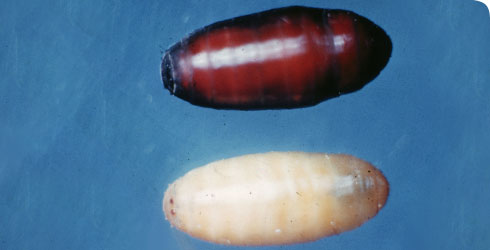Reproduction, lifecycle and dispersal
Reproduction
In Britain, carrion blowflies go through several generations per year, and the breeding season is only restricted by temperature.
Males attempt to mate repeatedly, but females may only mate once, shortly after emerging as adults.
Once mated, females store the sperm they receive in 3 special organs called the spermathecae and they will repulse further mating attempts for as long as the store lasts.
Females require a protein meal to mature an egg batch, and must find a suitable food source to deposit eggs on once they are mature.
Lifecycle
Larvae hatch from eggs laid by females. There are 3 larval stages or instars:
- The 1st and 2nd instars are of very short duration.
- Most of the growth takes place during the final, 3rd instar.
Once larval growth is complete, the maggots enter the post-feeding or wandering stage during which they crawl away from the carcass before burrowing into the soil to pupate.
During pupation, the cuticle of the larva contracts, hardens and darkens to form the puparium, which is the outer protective covering inside which the pupa develops.
On emergence the new adult must push its way out of the puparium, and burrow up to the soil surface.
Dispersal
Very little is known about the dispersal mechanisms for Calliphora vicina, although bluebottles are certainly capable of prolonged flight and can cover considerable distances.
No data is available on distances covered by Calliphora species, but studies that used carcasses to attract flies recovered marked Lucilia individuals as much as 6.5km away from their release point.
